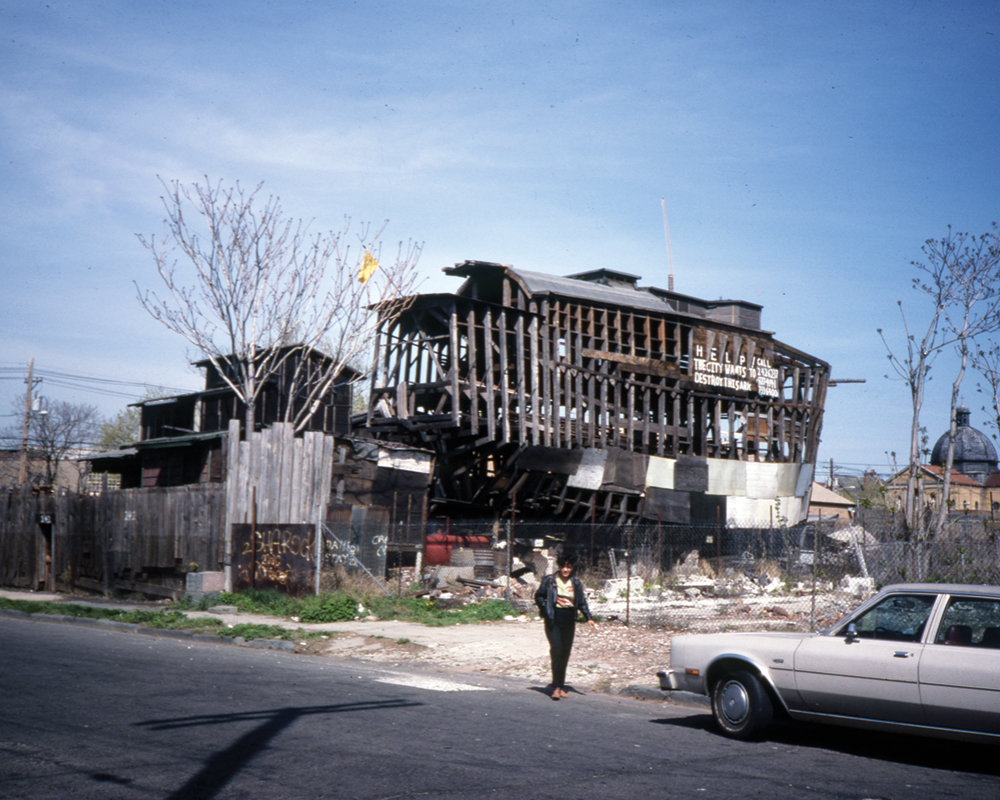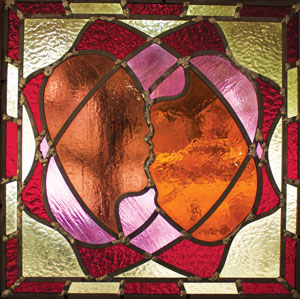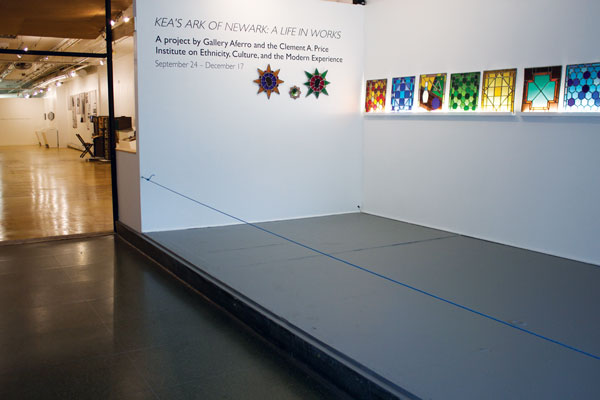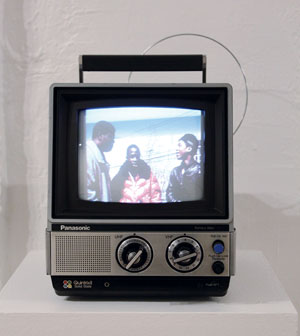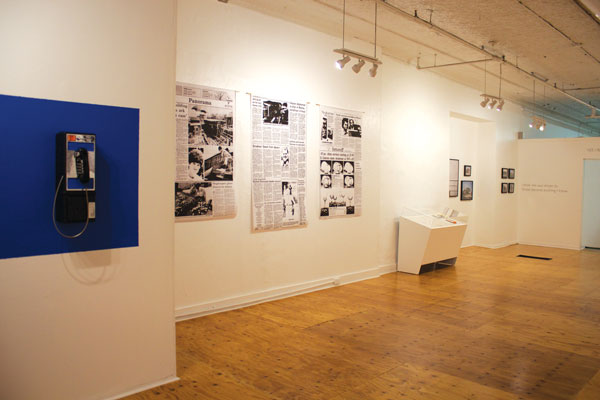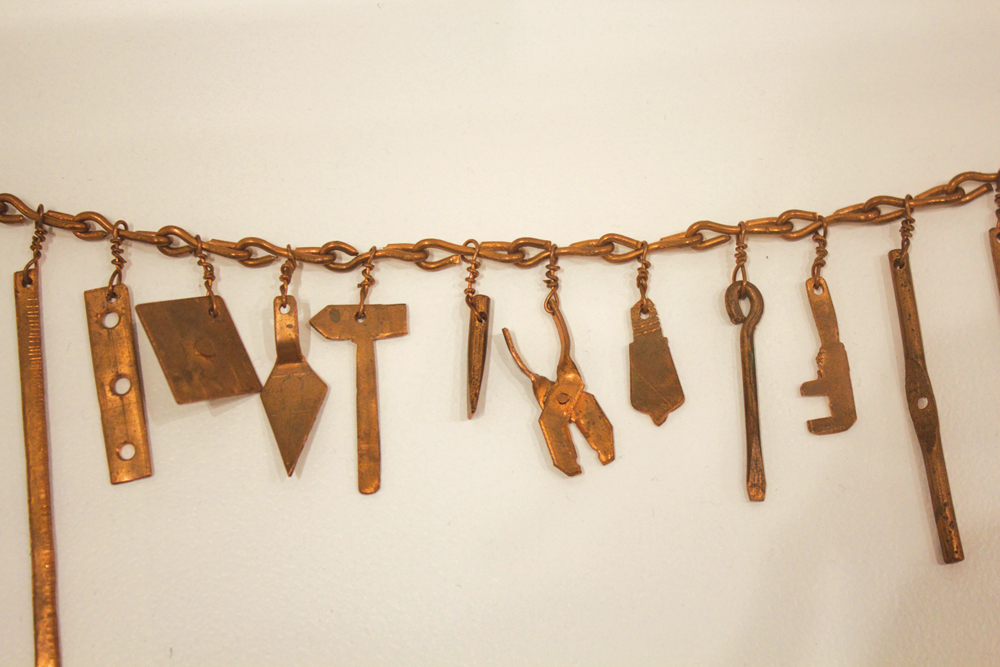Kea Tawana
Writer John ZeamanA new exhibit honors the woman whose unusual work inspired Newark after race riots three decades ago.
Some 30 years ago when I was starting out as a newspaper art critic, I got a call from a documentary photographer named Camilo Vergara. He said he had a story for me about an unusual structure in Newark, New Jersey. He called it “an ark.”
It was a little hard to get a handle on what he was talking about. Was this on Newark’s waterfront? No, it was on a high hill in the city’s Central Ward. How big did you say it was? He answered quite precisely that it was “86 feet long, 20 feet wide and more than 28 feet high.” While I tried to picture something this huge, he told me the strangest part of the story. The ark was being built single-handedly out of scavenged building materials by a middle-aged Japanese-American woman.
I scribbled down her name: Kea Tawana. It sounded like the name of New Zealand opera singer Kiri Te Kanawa. The whole thing sounded hokey—or surreal. But I wrote the address and went to have a look.
It was April 1987. Almost 20 years after Newark’s race riots, the Central Ward was still in a state of slow-motion collapse. The nearly three-story “ark” was easy to see amid this landscape of vacant lots and isolated, decrepit houses. It towered over the nearby Humanity Baptist Church, the curving, weathered ribs of its hull still bare, but its pilothouse looking weathertight and its bowsprit poking up at a jaunty angle.
Creating a Symbol
It didn’t take me long to find Kea. She was bustling about the site, a mannish figure in work clothes and, inexplicably, an orange Afro wig. She was angry. For several months Newark authorities had been threatening to tear down her creation to make way for redevelopment.
Some observers saw it as a symbol of hope— Newark rising phoenix-like from its ashes. But the city, which wanted to build middle-class housing on the site, didn’t like the image it projected.
“This is the first ark built in 5,000 years,” she told me. “It’s the only one in existence.” As Kea and I talked, neighborhood children, returning home from school, waved and called to her by name. I had a tour of the ship. She pointed proudly to construction details, such as the 4-by-6-inch hemlock beams held together with mortise-and-tenon joints and the tongue-and-groove planking for the skin of the hull. Everything had been dragged from abandoned buildings—schools, tenements, churches, synagogues, houses, banks. The heavy green porthole glass came from bank-teller windows. A 48-star United States flag had come from a school classroom. She had been assembling materials from the 1960s and had started construction in 1982.
What to me looked like a work of urban folk art, comparable to the Watts Towers in Los Angeles, was never intended by its creator to be art. She believed she was building a seaworthy vessel, designed according to specifications from scavenged Coast Guard books and marine construction manuals. Kea, born in Japan to a Japanese mother and an American-engineer father, hoped someday to sail it to the country of her birth to visit the grave of her mother, killed in a World War II bombing raid.
Never mind that she had no practical plan for getting it to the water. Even if it had eventually been made seaworthy with the 650 horsepower motor she planned on, it was too big to move through city streets beneath utility lines.
Grassroots Support
I wrote an appraisal that argued for its preservation as a unique work of art. It ran in the Sunday paper with a photo that spanned the width of the page. In the photo could be seen a sign calling for “Help,” listing phone numbers for several city agencies and the Newark Star Ledger.
Readers of my newspaper, The (Bergen) Record, responded by calling those telephone numbers, but one of the digits in one of the numbers was wrong, and some 250 people reached a clothing company in Whippany to voice support for the ark.
If good publicity could have saved the ark, it would still be there today. The story soon went national, culminating with Kea being named one of Newsweek magazine’s 51 unsung heroes. But no amount of publicity, nor dollar donations, nor testimonials from sociologists, architects and museum curators could reconcile the city to the ark’s continued presence in a redevelopment neighborhood— or anywhere in the city.
Kea exhausted her legal options that summer. Efforts to find a relocation site for the ark were fruitless, the expense of moving it prohibitive. She was served with a court order to destroy the ark and, by the end of that summer, the deed was done. She chose to do it herself, cutting it up with a chain saw in about a month’s time.
The last time I saw her was in October 1987. She was cutting up wood from the disassembled ark and selling it off as firewood. A boiler and a generator had fetched $700. The rest was hauled off to the dump.
“They took away 20 years of work,” she told me. “Everything I worked on is gone.”
During construction of the ark, Kea had lived in a small house she’d constructed some 16 years before and which sat beneath the ark’s stern. It looked like a crude shack on the outside but was as tight and neat as a ship’s cabin inside. She had sheared off its upper story and put the two parts atop a flatbed trailer and the back of a truck. She showed me the tiles for the old slate roof that had been stored carefully in boxes. She had diagrams, color-coded and precisely labeled, that indicated how her house would be reassembled when it arrived at its new location.
I asked her where that would be.
“I’m not saying a word,” she answered, eyes burning fiercely.
Her battles with city officials were not over. Her truck, with the house on it, was for some reason impounded. She was reported to have been briefly jailed. Then she disappeared.
Time Passes, Not Memories
Camilo Vergara, who had been her champion, called me from time to time about some new book or project. We asked each other about Kea, but neither had any news. Decades went by.
Late this past summer, I learned that she had recently died in Port Jervis, New York. She had always been vague about her age, but her birth date—now in Wikipedia—was given as 1935, making her 80 or 81 at the time of her passing.
It’s not known whether she ever succeeded in transporting or reassembling her house, but she had been living in an apartment when she died. From Newark she had reportedly gone for a while to Brooklyn and then to Port Jervis, a small, former industrial city on the Delaware River. She had been living in anonymity until a few years ago when some of her stained glass windows were exhibited in a local gallery, the UpFront Exhibition Space, which has a Facebook page.
Kea had arrived on the Internet.
This led to the planning of an exhibit that opened in late September at Newark’s Gallery Aferro. Cosponsored by the Clement A. Price Institute on Ethnicity, Culture and the Modern Experience at Rutgers-Newark, the show was originally focused entirely on the story of the ark. But Kea’s death caused a reset, curator Emma Wilcox says. The show (which runs until December 17) was expanded and recast as Kea’s Ark of Newark: A Life in Works. It features not only a wealth of documentary material about the ark, but 30 of her stained glass windows as well as examples of her woodwork, copper jewelry, handmade books and blueprints for a utopian city.
Wilcox, 36, was a child when Kea built and destroyed her ark, but as a prominent member of the Newark art scene (she is co-owner of Gallery Aferro and a working artist), she had long been aware of the story. The gallery has assembled photographs, maps, public records, testimonials, newspaper stories and television broadcasts. There’s even a pay phone that visitors can pick up to hear reminiscences about the ark.
“I knew that architecture students and college classes visited the ark, but I never knew how many grade school teachers brought their students,” Wilcox says. “One of our oral histories is that of a woman in her 40s recalling how she was taken to see the ark when she was in the sixth grade.”
Kea didn’t come to Port Jervis empty handed. Her stained glass windows, for example, use glass that she gathered from Newark’s abandoned churches and synagogues many years before and which she reconfigured into her own designs. She never lost her creative edge, working right up to the end of her life. And the story of Kea’s ark continues to inspire people today. Among them, Wilcox says, is an artist in Sweden who is doing a full-length graphic novel about the ark.
Kea may have lost her creation to shortsighted politicians and bureaucrats, but at least it’s getting the afterlife it deserves.
Columnist John Zeaman is a freelance art critic who writes regularly for The Record and Star Ledger newspapers. His reviews of exhibits in New Jersey have garnered awards from the New Jersey Press Association, the Society of Professional Journalists (New Jersey chapter) and the Manhattan-based Society of Silurians, the nation’s oldest press club. He is the author of Dog Walks Man (Lyons Press, September 2010) about art, landscape and dog walking.
Editor’s Note: A variety of lectures, readings and other programs supplement the exhibit, including a radio play composed of Facebook comments about the ark and inspired by Kea’s skill at making and using homemade radios. For information about this and other events see aferro.org or call 973-353-9533.
Gallery Aferro is at 73 Market Street in Newark. Open noon to 6 p.m. Wednesday through Saturday.


